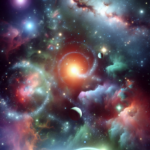Do you imagine space as being completely black?
Space can look completely black to the eye because there is no atmosphere to scatter sunlight and fill the sky with diffuse light the way Earths atmosphere does. In the vacuum between stars, light travels in straight lines from discrete sources, so unless your line of sight intersects a star, planet, or illuminated dust cloud you see darkness. Human vision also requires a direct or scattered visible photon flux to register brightness, so empty stretches of space appear as a deep black background punctuated by points of light.
The classic question about a uniformly bright night sky is addressed by Olbers paradox, and the modern resolution explains why the cosmos is not flooded with visible starlight. The universe has a limited age and is expanding, so many potential light sources are too distant for their light to have reached us yet, and the expansion redshifts photons out of the visible band. As a result, the cumulative starlight that might otherwise brighten every line of sight is diminished, leaving a predominantly dark sky in visible wavelengths.
Even though we perceive blackness, space is not empty of electromagnetic radiation or faint glow: there are contributions like zodiacal light from interplanetary dust, diffuse galactic light, and emissions at nonvisible wavelengths such as the cosmic microwave background. These sources are often too faint or at wavelengths our eyes cannot detect, so sensors and telescopes reveal a much more complex and luminous universe than naked-eye observation suggests.
Why does outer space appear black from Earth and orbit? (atmosphere, light scattering, and perspective)
Outer space appears black from Earth and orbit primarily because there is no atmosphere in space to scatter sunlight into your line of sight. On Earth, molecules and tiny particles in the atmosphere scatter shorter (blue) wavelengths of sunlight in all directions — a process called Rayleigh scattering — which fills the sky with diffuse light and makes it look bright and blue during daytime. In the vacuum of space, that scattering mechanism is essentially absent, so sunlight travels in straight lines and does not produce a bright background glow; against that unlit backdrop, space looks black.
Even in low Earth orbit, where residual atmosphere is present, the sky outside a spacecraft or above the atmosphere still appears black because the remaining air is too thin to scatter enough sunlight to brighten the entire field of view. Astronauts report a pitch-black sky when they look away from the Sun or illuminated Earth. Cameras and human eyes exposed to sunlit surfaces will often fail to see faint stars because of the high contrast between brightly lit objects and the unscattered darkness beyond, but that darkness is not an absence of light sources — it’s the absence of scattered light between you and those sources.
Perspective and human vision also shape why space appears black. Human eyes and camera sensors have limited dynamic range, so when pupils constrict in bright daylight or exposure settings adapt to sunlit scenes, relatively faint starlight becomes invisible. From the ground the atmosphere’s scattered light dominates the scene; from orbit the same adaptation leaves the background uncompensated and black. Around the Earth’s limb you can see a thin glowing band where sunlight is scattered by the atmosphere along a long path, which emphasizes that the visible sky brightness depends on scattering geometry, wavelength (blue light scatters more), and viewer perspective rather than an intrinsic color of space itself.
Olbers Paradox explained: the scientific reason the night sky is dark
Olbers paradox asks a simple, striking question: if the universe were infinite, eternal, and uniformly filled with stars, then every line of sight should end on a star and the night sky would be as bright as a star’s surface. This thought experiment highlights an apparent contradiction between that idealized model and the observed dark night sky. Historically posed in the 19th century, the paradox crystallizes why the actual darkness of the sky is a powerful clue about the cosmos.
The principal scientific resolution is that the universe is not infinite and eternal in the sense required by the paradox: it has a finite age and a finite observable universe. Because light travels at a finite speed, we can only see objects whose light has had time to reach us since the universe began; distant stars beyond this cosmic horizon simply haven’t had time to illuminate our part of the sky. In addition, stars are not eternal sources — they form, evolve, and die — so the number of luminous sources at any time is limited.
Cosmic expansion adds a second, crucial effect: light from very distant galaxies is stretched to longer wavelengths by redshift, shifting visible starlight into the infrared and microwave bands and reducing its energy per photon as received here. The combined results — a finite, evolving population of luminous sources, limited light-travel time, and redshifting by expansion — explain why the sky is mostly dark at night despite the enormous number of stars, with the cosmic microwave background remaining the dominant pervasive glow at microwave wavelengths rather than in visible light.
When space isnt black: stars, nebulae, planets, and scattered sunlight that add color
Space is rarely a uniform black; the universe shows color whenever light is produced, reflected, or scattered. Bright points and diffuse glows come from different physical processes: stars emit light according to their surface temperatures, glowing in hues from blue-white to orange-red; nebulae can glow in characteristic emission lines when gas is ionized; and planets and moons reflect sunlight with colors set by their surfaces and atmospheres. Even tenuous dust in the solar system and interstellar medium scatters sunlight, creating faint but observable glows that add subtle color to the night sky.
Stars and nebulae are two of the most obvious color sources in deep-sky views. Stellar color is a direct indicator of temperature and composition, so star fields often show a mix of blue, white, yellow, and red points. Emission nebulae appear colored because atoms in the gas emit light at specific wavelengths—hydrogen often contributes red tones while oxygen emissions can produce greenish–blue light—while reflection nebulae scatter starlight and tend to look bluer because shorter wavelengths scatter more efficiently. Dark nebulae, by contrast, block background light and can create dramatic contrasts that emphasize nearby colored regions.
Planets and scattered sunlight add more variety closer to home. Planetary hues arise from surface minerals, cloud chemistry, and atmospheric scattering: rocky surfaces, ice, dust, and complex aerosols produce the reds, browns, whites, and blues seen in telescope and spacecraft images. Within the inner solar system, sunlight scattered by interplanetary dust produces faint phenomena such as the zodiacal light and gegenschein, while atmospheric scattering on planets (including Earth) shifts colors toward blue at shorter wavelengths. Astronomical imaging techniques—narrowband filters, color composites, and false-color processing—also reveal and sometimes enhance these natural colors for scientific study and public viewing.
How human vision and cameras influence the idea of space being completely black
Human vision is tuned to detect contrast and scattered light rather than absolute darkness, so the absence of an intervening atmosphere in space changes what we perceive. On Earth, molecules and aerosols scatter sunlight to create a bright blue sky that provides diffuse illumination; in space there is almost no scattering, so light from stars and planets travels in straight lines and doesn’t light up the surrounding void. Because our eyes rely on adaptive processes (pupil size and photoreceptor adaptation) optimized for scenes with some ambient illumination, isolated bright objects against a nearly unlit background appear as points of light surrounded by what we interpret as total blackness.
Cameras and imaging sensors influence that same impression through exposure choices and sensor physics. A camera’s exposure time, aperture and sensitivity (ISO) determine how much light is collected from faint objects; short exposures capture bright objects without revealing faint background detail, while long exposures integrate more photons and can render nebulae and distant stars that are invisible to the naked eye. Sensor noise, dynamic range and processing also shape the final image: limited dynamic range can force a photographer to expose for bright highlights and leave the rest of the frame effectively black, reinforcing the idea that space is completely dark.
The interaction between human perception and camera technology explains many common misconceptions about the “blackness” of space. To the unaided eye a spaceship window, the Moon’s surface, or a shining star appear against a black background because the eye cannot accumulate light over time like a camera long exposure, and because there is no atmospheric glow to provide context. Conversely, astrophotography and telescopes that gather large amounts of light reveal rich, faint structures—galactic dust, emission nebulae, and star fields—that belie the simple idea of an entirely black cosmos.
Post-processing and imaging techniques further influence how space is portrayed in photos and media. Photographers routinely use longer integrations, stacking, and contrast stretching to pull out faint details from sensor data; these techniques can either emphasize the darkness of the void by preserving deep black backgrounds or reveal vast faint structures by boosting low-level signal. As a result, both human vision and camera technology play central roles in why space is often perceived and presented as completely black.
Array










